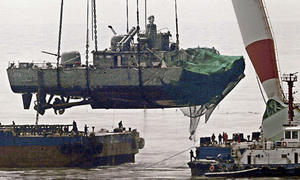Case closedCheonan destroyed by North Korean torpedoes
Traces of explosives collected from the wreckage of a sunken South Korean naval ship and the sea bed have been found to be identical in composition to those used in North Korean torpedoes; investigators found a powerful bomb ingredient, known as RDX, in the wreckage; ship was destroyed by an underwater “non-contact” explosion, typical of an advanced torpedo design

Stern of the sunken South Korean patrol ship Cheonan being lifted for examination // Source: guim.co.uk
When the South Korean patrol ship Cheonan sank on 26 March in waters near the Yellow Sea border between North and South Korea, many in the media, HSNW included, gave in to the temptation to believe — and, worse, publish — the stories of a couple of North Korean defectors who claimed a midget submarine with North Korean human torpedoes were responsible for the attack. That story was a fabrication, and we published a retraction five days later (see “Update: South Korean corvette was sunk by conventional torpedoes,” 27 April 20109 HSNW).
The verdict about the type of attack which destroyed the Cheonan is now in. Yonhap News reports that traces of explosives collected from the wreckage of a sunken South Korean naval ship have been found to be identical in composition to those used in North Korean torpedoes, a senior military official said Tuesday. The finding represents a step forward in South Korea’s probe into suspicions that North Korea attacked the 1,200-ton patrol ship Cheonan on 26 March.
South Korea collected traces of explosives from the wreckage and the seabed of the site of the sinking and compared them with explosives contained in a stray North Korean torpedo that the country discovered on the southern coast seven years ago. The result showed that the explosives have the same composition, the military official said on the condition of anonymity. The stray North Korean torpedo was found without a warhead, but it contained explosives that were used as a propellant, the official said.
“After analyzing explosive traces recovered from the Cheonan and the seabed, we’ve got hold of evidence decisive enough to conclude (the Cheonan) came under a North Korean torpedo attack,” the official said.
“The explosive traces were found to be identical in composition to the explosives in the North Korean torpedo collected seven years ago,” the official added.
Defense Minister Kim Tae-young said last week that investigators found a powerful bomb ingredient, known as RDX, in the wreckage. There have been reports that more explosive substances have been found, but the defense ministry neither confirmed nor denied them.
After an initial examination of the wreckage, investigators blamed an underwater “non-contact” explosion, possibly from a torpedo, as the likely cause for the sinking.
South Korea plans to announce the outcome of the investigation Thursday.
The sinking has escalated tensions on the divided peninsula, though Pyongyang has denied responsibility. South Korean officials are considering bringing the case to the U.N. Security Council, seeking new sanctions against Pyongyang, if the North’s involvement is confirmed.
With the investigation apparently concluding that North Korea is responsible for the sinking, South Korea and the United States agreed to hold a large-scale anti-submarine military exercise in the Yellow Sea in the second half of this year, the official said.
Earlier in the day, South Korean president Lee Myung-bak telephoned President Barack Obama and agreed to cooperate in handling the issue. Lee and Obama emphasized the importance of obtaining a full accounting of the Cheonan incident and “committed to follow the facts of the investigation wherever they lead,” the White House said in a statement.
The two Koreas are still technically in a state of war as the 1950-53 Korean War ended in a truce, not a peace treaty.
